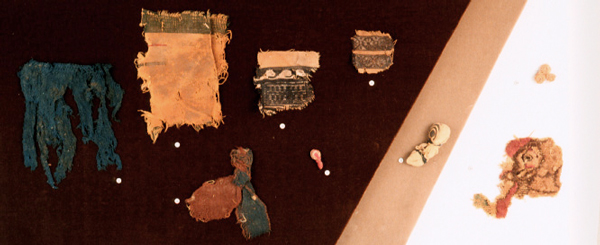Surface:
Layer A, Area 200
This area is identified
as a large “rubbish heap.” In it were found artifacts
in a variety of materials, including a pottery spindle whorl, glass
sherds, beads, a bronze ring, ostraca and papyri (writing materials),
and a palm nut. Also found were thirty-eight small and fragmentary
cloth artifacts, most of which show traces of extensive use and
mending. The cloth artifacts are of various colors, patterns and
techniques, and conditions, including one item identified as a “rag
doll.”
|
Below
the Surface:
Layer B, Structure 36
A similar “rag
doll” was found in the B layer, in unit 36, a structure that
is neither located on any maps or publications nor characterized
as a locus in the expedition records. It is possible that neither
of these cloth figures is a doll intended for play. Typically dolls
have recognizable features. The doll in the photograph at right
represents a swaddled infant, with hair of multicolored wool, a
face of minimally painted bone, and body (an undecorated extension
of the head) enveloped in a bundle of small rags.
|
Below
the Surface:
Layer C, House 88
This unit is locatable
on maps and identified in records as a multi-roomed house. Cloth
artifacts were found in interior rooms C and K. The tiny pendant
attachments (note holes at center) may have been purely ornamental
in nature. They appear to combine linen and wool threads and thus
probably were not wound for sewing. The excavators suggested that
the pendants served as amulets, perhaps because they are not wound
tightly or carefully enough to serve decorative or utilitarian purposes.
The decorative motifs of the colorful cut-pile rug have not yet
been identified.
|










